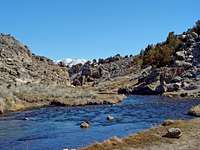-
 9166 Hits
9166 Hits
-
 89.01% Score
89.01% Score
-
 28 Votes
28 Votes
|
|
Canyon |
|---|---|
|
|
Hiking |
|
|
Overview
There are many geothermal areas and hot springs in the Eastern High Sierra. One of the best known is Hot Creek Gorge, which cuts across the southeast side of the resurgent dome in the Long Valley Caldera. The gorge can be easily accessed via a dirt road east of Highway 395. The geothermal area has nice informational signs and viewing areas.Geography and Geology
Hot Creek lies at the bottom of a 100-foot deep gorge that cuts across the southeastern flank of the resurgent dome in the Long Valley Caldera. Hot Creek starts as Mammoth Creek in the Mammoth area west of the Long Valley Caldera. When Mammoth creek flows eastward into the Caldera much of the cold water seeps into the ground and is heated by the magma underneath the Caldera. Near Casa Diablo, the site of the Mammoth Pacific Geothermal Power Plant, the heated groundwater mixes with the cold surface water from Mammoth Creek, which then changes its name to Hot Creek. Hot Creek flows further east through the gorge and eventually drains into Owens River, which flows into Lake Crowley south of the Caldera. The rocks on both sides of the gorge are a rhyolitic lava flow that erupted from a vent on the southern rim of the Long Valley Caldera about 300,000 years ago. The lave flow is about 3 miles long and 500 feet thick. Along the creek, the rhyolite has been bleached and oxidized to white clay in many places by the hot water.
Geothermal Area
After earthquakes caused by movement of the magma under the Caldera the temperature of the Hot Creek water can rise significantly. Because of increasing unrest of volcanic activity in this area the Hot Creek Geothermal Area, a popular swimming site, has been closed for swimming by the United States Forest Service since 2006. Signs warn of scalding water, arsenic in the water, sudden temperature changes, unpredictable eruptions, and unstable ground. More than a dozen people have died and many more seriously injured since 1968 there. About 250 liters per second of thermal water are discharged in Hot Creek Gorge. The geothermal site is reached by the Hot Creek Hatchery Road in summer. In winter the last 1.5 miles are closed due to snow cover. The Hot Creek Geothermal Area is famous for its sulfur smell. There is a picnic area with parking and rest rooms. From the parking area stairs and railings lead down to the creek and the scalding pools of water and hot steams. A very nice trail along the south bank of the creek leads west out of the gorge. A short climb up the south bank leads back to the road.



